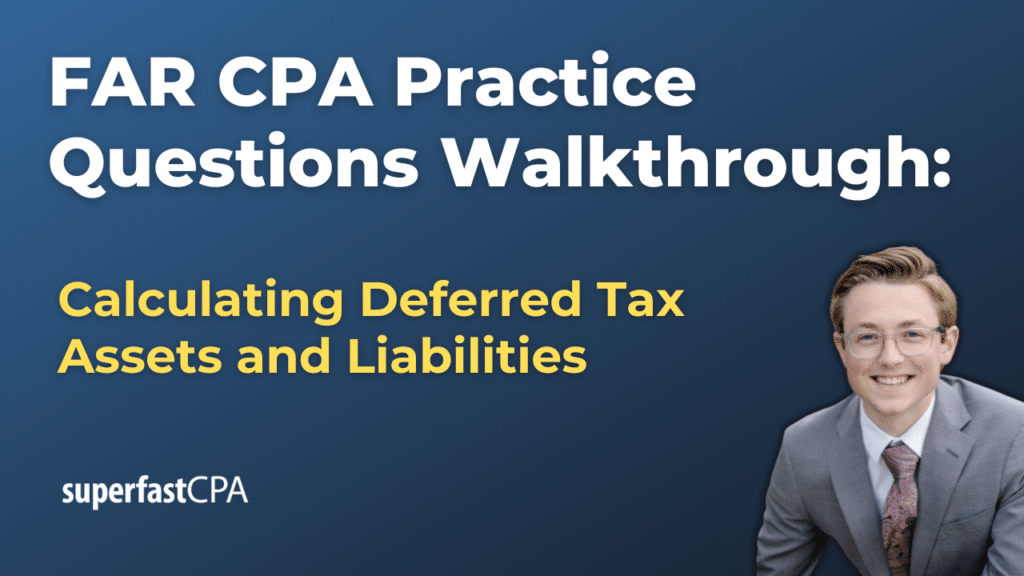In this video, we walk through 5 FAR practice questions about calculating calculating deferred tax assets and liabilities resulting from book-to-tax basis differences. These questions are from FAR content area 3 on the AICPA CPA exam blueprints: Select Transactions.
The best way to use this video is to pause each time we get to a new question in the video, and then make your own attempt at the question before watching us go through it.
Also be sure to watch one of our free webinars on the 6 “key ingredients” to an extremely effective & efficient CPA study process here…
Calculating Deferred Tax Assets and Liabilities
When businesses report financial results, differences often arise between the book basis (financial reporting under U.S. GAAP) and the tax basis (tax reporting under IRS rules). These differences result in deferred tax assets (DTAs) or deferred tax liabilities (DTLs), which represent future tax savings or obligations.
This guide will walk you through how deferred tax assets and liabilities are calculated, with examples of common scenarios such as allowance for credit losses, inventory costing methods, and property, plant, and equipment (PP&E).
What Are Deferred Tax Assets and Liabilities?
- Deferred Tax Asset (DTA): Arises when a company pays more taxes now than it will in the future, creating a tax benefit down the line.
- Example: Accrued expenses (e.g., warranty costs) recognized for book purposes but not yet deductible for tax purposes.
- Deferred Tax Liability (DTL): Arises when a company pays less tax now but will owe more in the future as the temporary difference reverses.
- Example: Accelerated tax depreciation creates a lower taxable income now, but taxable income will increase in later years.
The key to understanding DTAs and DTLs lies in temporary differences—timing differences that reverse in future periods—and the enacted tax rate applicable when they reverse.
Identifying Book-Tax Basis Differences
Book-tax differences fall into two main categories:
- Temporary Differences: Differences that reverse over time and give rise to deferred tax assets or liabilities.
- Permanent Differences: Differences that do not reverse and therefore do not create deferred tax assets or liabilities.
Common Examples of Book-Tax Basis Differences
Here are three common examples that result in deferred tax assets or liabilities:
A. Allowance for Credit Losses
- Book Treatment: Under U.S. GAAP, companies estimate and record expected credit losses (e.g., uncollectible receivables) as an expense in the current period.
- Tax Treatment: The IRS does not allow a deduction until the bad debt is actually written off.
- Impact:
- Temporary difference creates a deferred tax asset.
- Example:
- Allowance for credit losses = $50,000.
- Enacted tax rate = 25%.
- Deferred tax asset = $50,000 × 25% = $12,500.
B. Inventory Costing Methods
- Book Treatment: Companies may use FIFO (First-In, First-Out) for financial reporting, which often results in higher income during inflationary periods.
- Tax Treatment: Many companies use LIFO (Last-In, First-Out) for tax purposes, which reduces taxable income in the current period.
- Impact:
- Temporary difference creates a deferred tax liability because taxable income is lower now but will increase when inventory is sold.
- Example:
- Inventory difference = $80,000 (LIFO reserve).
- Enacted tax rate = 25%.
- Deferred tax liability = $80,000 × 25% = $20,000.
C. Property, Plant, and Equipment (PP&E)
- Book Treatment: Depreciation for book purposes is often calculated using the straight-line method, spreading costs evenly over the asset’s life.
- Tax Treatment: The IRS allows accelerated depreciation methods (e.g., MACRS), which result in higher depreciation expenses in the earlier years of the asset’s life.
- Impact:
- Temporary difference creates a deferred tax liability because taxable income is lower now but will be higher in future periods when tax depreciation slows down.
- Example:
- Tax depreciation = $100,000; Book depreciation = $60,000.
- Difference = $40,000.
- Enacted tax rate = 25%.
- Deferred tax liability = $40,000 × 25% = $10,000.
Calculating Deferred Tax Assets and Liabilities
- Identify Temporary Differences: Determine the amounts that create differences between book income and taxable income.
- Apply the Enacted Tax Rate: Use the tax rate that will apply in the period when the temporary differences reverse.
- Determine Net Position: Subtract the deferred tax liabilities from the deferred tax assets to find the company’s net deferred tax position.
Example: Combining Multiple Differences
Let’s consider a scenario with multiple temporary differences:
Horizon Equipment Rentals reported the following:
- Depreciation Difference: Tax depreciation exceeded book depreciation by $70,000.
- Prepaid Rent: $30,000 of rent income was taxed now but deferred in book income.
- Enacted Tax Rate: 25%.
Solution:
- Depreciation Difference: Creates a deferred tax liability.
- $70,000 × 25% = $17,500.
- Prepaid Rent: Creates a deferred tax asset.
- $30,000 × 25% = $7,500.
- Net Deferred Tax Position:
- Deferred tax liability = $17,500.
- Deferred tax asset = $7,500.
- Net deferred tax liability = $10,000.
Key Takeaways
- Deferred Tax Assets (DTAs): Represent future tax savings when temporary differences reverse (e.g., accrued expenses, prepaid taxes).
- Deferred Tax Liabilities (DTLs): Represent future tax obligations caused by temporary differences (e.g., accelerated tax depreciation).
- Temporary vs. Permanent Differences: Temporary differences reverse over time, while permanent differences do not impact deferred taxes.
- Tax Rate Application: Always use the enacted tax rate for the period in which the temporary difference is expected to reverse.













